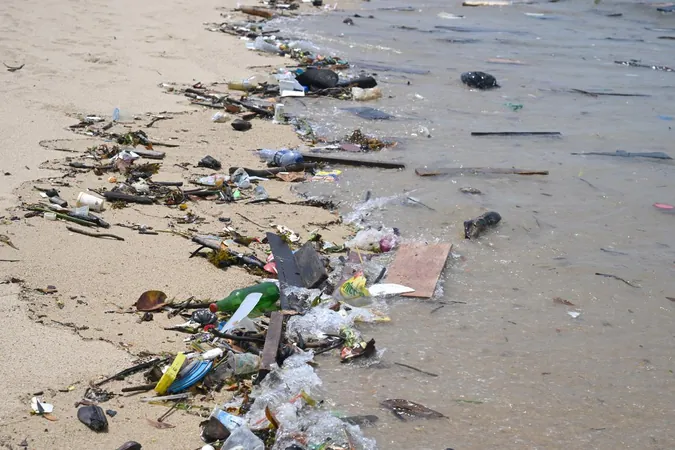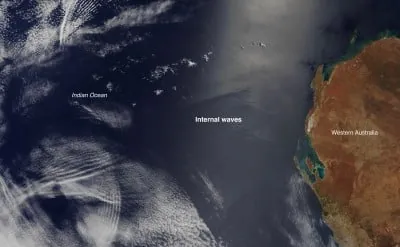
Shocking New Study Reveals 97% of Plastic Waste on Singapore's Beaches Comes from Offshore Sources!
2025-01-16
Author: Siti
SINGAPORE – A recent study by the National Environment Agency (NEA) has revealed that a staggering 97% of the plastic waste littering Singapore’s picturesque beaches is generated from offshore sources!
This finding is alarming, especially during the country’s tumultuous monsoon seasons, when heaps of plastic debris become all too familiar.
Study Overview
The NEA’s extensive research, commissioned in 2021, was designed to pinpoint the origins of plastic waste polluting Singapore’s shores. Conducted over a year, the study involved monthly sampling of various inland and coastal waters at recreational beaches. Researchers analyzed the plastic debris, focusing on its size, alongside other contributing factors like rainfall and wind speed.
Key Findings
The results were instrumental: only around 3% of the macro and micro plastics found on Singapore's beaches could be traced back to inland waterways. Instead, the overwhelming majority—97%—originated from the ocean, confirming that marine vessels or currents played a significant role in transporting this waste.
Using international classification standards, the study categorized larger particles as macroplastics (over 5mm) and smaller fragments as microplastics (under 5mm). Surprisingly, over 90% of samples gathered from river mouths showed no presence of microplastics, reinforcing the theory that the litter on beaches largely comes from the sea.
Weather Patterns and Litter Accumulation
The study also highlighted how weather patterns impact the quantity of marine litter on beaches. During the northeast monsoon season from November to March, winds blow predominantly from the north, resulting in higher volumes of debris accumulating along northern beaches like Sembawang Park Beach and Pasir Ris Beach. Conversely, during the southwest monsoon from April to September, southern beaches, including East Coast Park, experienced a surge in waste due to winds coming from the south.
Macroplastic Accumulation
What's particularly eye-opening is the degree of macroplastic accumulation. The amount of large plastic debris found on northern shores during the northeast monsoon was three times greater than that found on southern beaches during the opposing season. This variance is likely due to the more open waters of the Singapore Strait in the south, which facilitate broader dispersal of plastic waste.
Microplastics and Their Sources
Notably, the research found that larger plastic debris travels much farther due to its size and surface area, allowing it to be carried by winds over long distances. Most concerning, microplastics sampled predominantly consisted of materials from post-consumer products such as takeaway containers and plastic bags, specifically made of polypropylene, accounting for up to 79% of the microplastics discovered.
Global Context and Local Response
The urgency of this study's findings is compounded by international events. Just last November, nations failed to forge a comprehensive agreement on a global treaty to combat plastic pollution, underscoring the need for immediate local actions.
In response to these revelations, Singapore has undertaken a national action strategy targeting marine litter, focusing on waste management, stringent anti-littering laws, and the promotion of recycling. Initiatives such as a charge for disposable carrier bags and an upcoming beverage container return scheme slated for 2026 are steps in the right direction.
Volunteers and Cross-Border Waste Issues
However, volunteers on the ground, such as those from Stridy—a non-profit organization dedicated to coastal clean-ups—are noticing a trend that warrants attention. Many plastic items littering the shores are traced back to Indonesia, highlighting a cross-border waste problem that needs addressing.
Community Involvement and Global Responsibility
“During our clean-ups, it's clear that the brands and languages we encounter on the debris suggest they aren’t local products,” said Mr. Yasser Amin, chief officer of Stridy. “This study reinforces the importance of supporting workers dedicated to cleaning up these shores, especially during peak seasons like the monsoons.”
In light of this crisis, it’s vital that Singapore amplifies its efforts to combat rising plastic pollution, not just through policies but by fostering international cooperation and community involvement in clean-up initiatives. As these findings suggest, protecting our shores is not just Singapore's issue; it’s a global responsibility. How will Singapore tackle this mounting challenge? Only time will reveal the answers.



 Brasil (PT)
Brasil (PT)
 Canada (EN)
Canada (EN)
 Chile (ES)
Chile (ES)
 Česko (CS)
Česko (CS)
 대한민국 (KO)
대한민국 (KO)
 España (ES)
España (ES)
 France (FR)
France (FR)
 Hong Kong (EN)
Hong Kong (EN)
 Italia (IT)
Italia (IT)
 日本 (JA)
日本 (JA)
 Magyarország (HU)
Magyarország (HU)
 Norge (NO)
Norge (NO)
 Polska (PL)
Polska (PL)
 Schweiz (DE)
Schweiz (DE)
 Singapore (EN)
Singapore (EN)
 Sverige (SV)
Sverige (SV)
 Suomi (FI)
Suomi (FI)
 Türkiye (TR)
Türkiye (TR)
 الإمارات العربية المتحدة (AR)
الإمارات العربية المتحدة (AR)